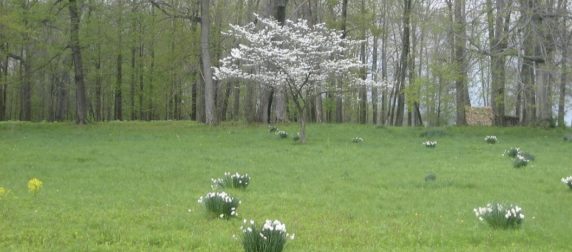Lawn Care
When I was in college there was a running joke about “we don’t plant lawns, we tear them out and build gardens”. Indeed, lawns typically are more labor intensive and less interesting than properly designed ornamental gardens. But large expanses of turf can be attractive. (Especially with a few trees sprinkled in !) Mowing can even be relaxing with today’s large comfy mowers. While we aren’t lawn specialists, we do know something about lawn care. With spring just around the corner this would be a good time to discuss the topic.
As with many gardening topics, lawn care is not as complicated as the “pundits” might have you believe. My lawn is about 40 years old and I’ve never fertilized it or used crab grass killer! I’ve also never dethatched or aerated. I just mow, over seed the thin spots and spray the broadleaf weeds as they appear. You’ll see many articles today talking about the need to aerate and dethatch. Aerating is generally a good idea and certainly doesn’t hurt anything. Especially with our dense, compacted clay soils it helps provide oxygen to the root zone. But dethatching is only helpful to old lawns. It takes about 20 years to create a thatch buildup so dethatching a young lawn is a waste of time.
Fertilization? The lawn care companies would have you fertilizing your lawn every month, but this could be reduced to once a year. Fall is the best time to fertilize as it promotes root growth. Spring applications just make you mow more often. Again, I’m just providing an overview here with some practical information. Golf courses and lawn lovers might justify spending a lot more time and money on lawn care.
My recommendations are as follows:
- Mow frequently and set your blade at 3” high.
- Overseed the bare spots spring and fall as needed. (soil temperatures need to be above 50 degrees for grass seed to sprout !)
- Mix a 2,4-D broadleaf weed killer in a hand sprayer and hit the weeds as they appear. (If you have a large lawn full of weeds you might need to use a pull behind sprayer for this job. Or you could use a granular product but this must be applied in the morning with dew on the grass to make the granules stick to the grass blades)
- Fertilize in October to feed the roots and increase the density of your lawn.
Organics? You may see offerings for “organic lawn treatments”. Of course this sounds good but the bottom line is that it will be more expensive and less effective. My suggestion is to reduce the treatments to only what is necessary and better target the problem areas as necessary.
Irrigation? This is one of my pet peeves which I wrote about in June of 2017. Irrigation systems are not necessary for everybody. The only time of year your lawn needs to be irrigated is in the middle of a bad drought to keep it from going beyond dormant to dead! I can only recall one year in recent history when we had such a bad drought. Of course it’s not a bad idea to turn on a sprinkler in late July or August to relieve your lawn of drought stress. This is also true even for big trees and landscape beds. But automatic irrigation every other day year ‘round is over kill. I can’t count the number of times I’ve seen irrigation running in the rain or spraying out into the street.
What type of turfgrass should I use? Generally in this area we use a grass seed mix of Kentucky bluegrass and fine fescue. The bluegrass should dominate in the sunny areas and the fine fescue is meant to fill in the shady spots. I like a little bit of “annual rye” in the mix because it germinates fast and helps stabilize the ground while the slower germinating seeds sprout. You’ll hear about “turf type tall fescue” these days. This is a tougher grass which is a good option for dry areas with more foot traffic. However it shouldn’t be mixed with bluegrass as it’s lighter green and slightly coarser which would be noticable. Also be very careful not to get “coarse tall fescue” which is very coarse and typically used for football fields and pastures. If you seed this you’ll be wanting to kill your lawn and start over.
That brings up another point. I get many calls from people with bad lawns wanting to “kill it all, till it up and start over”. This is usually not necessary. It’s much easier to just overseed, water, kill the broadleaves and otherwise follow the above recommendations. You can’t “wave a magic wand” and get a beautiful lawn. Lawn care is an ongoing, gradual process. It takes about 2 years for a newly seeded lawn to knit in and become dense. Sod is an option but is MUCH more expensive and labor intensive to lay.
I hope this helps as we get into another growing season!


Comments are closed.